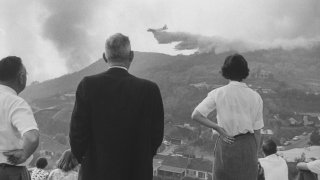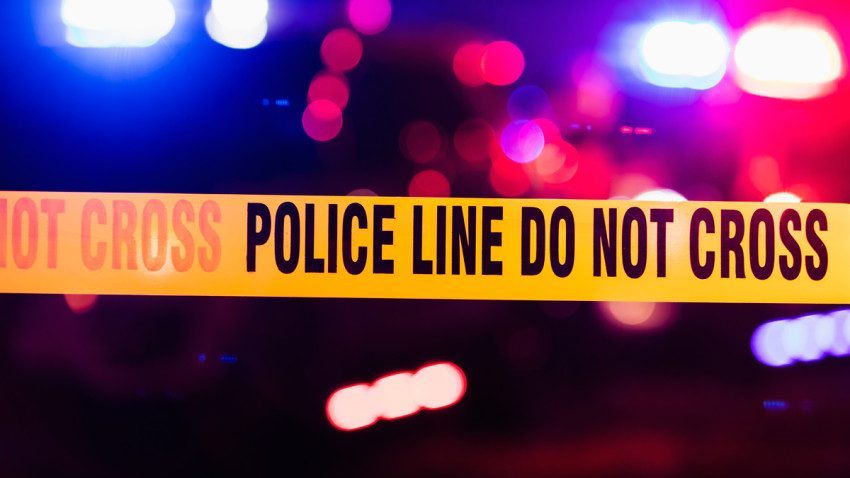
In November 1961, a disastrous brush fire destroyed nearly 500 homes when it roared over a mountain ridge and swept through canyons in Los Angeles' Bel Air community, a grim illustration of the potential for wildfire devastation in Southern California.
The two-day Bel Air Fire disaster started in the Santa Monica Mountains and, fanned by seasonal strong Santa Ana winds, became one of the most destructive fires in the region's history. It also led to safety changes and future standards in fire prevention.
Dubbed "a tragedy trimmed in mink" by "Life Magazine," the fire destroyed homes owned by big-name Hollywood stars, including residences of Burt Lancaster and Zsa Zsa Gabor. A Getty photo shows former Vice President and future President Richard Nixon, dressed in a shirt and tie, watering down a rooftop with a garden hose at a rented house on North Bundy Drive. He and wife Pat eventually evacuated, suitcases in hand, along with thousands of other residents.
Photos: Scenes From the November 1961 Bel Air Fire Disaster
Like the Oct. 28 Getty Fire that destroyed eight homes, the Bel Air Fire of 1961 started in the mountains hugging what was then a recently completed stretch of the 405 Freeway. The Getty Fire remained on the west side of the freeway connecting the San Fernando Valley with the Sepluveda Pass and West Los Angeles, but the Bel Air Fire jumped roads and charged up and down canyon walls in a terrifying run toward residential areas east of the freeway.
The location of those homes, the construction material used to build them, topography and extremely dangerous weather conditions created a dreadful situation for firefighters. A nearly 30-minute Los Angeles Fire Department documentary called "Design for Disaster" was produced after the fire. The sternly narrated production called the densely packed homes nestled on hillsides covered in dry brush "a serious problem in fire protection, even under the best of conditions."
Local
Get Los Angeles's latest local news on crime, entertainment, weather, schools, COVID, cost of living and more. Here's your go-to source for today's LA news.
Timeline of Events
Just after 8 a.m. on Monday Nov. 6, 1961, a construction crew reported a brush fire on a northern slope of the Santa Monica Mountains, a range of deep canyons and soaring ridge lines that extends from Griffith Park in the east to LA’s western city limits and beyond to Ventura County. It includes the densely populated communities on canyon floors and hillsides that are world-renowned for their expensive residences — homes to the rich and famous.
But for firefighters, those communities were known for the potential threat of a large-scale disaster due in part to the surrounding topography with combustible ground cover, narrow roads, water supply issues and densely packed neighborhoods.
Those fears were realized when the brush fire, driven by powerful Santa Ana winds of 25 to 50 mph with even stronger gusts, burned through dry brush on the San Fernando Valley side of the mountain and leaped across Mulholland Drive. It grew in size as it burned down a south-facing mountain slope and into the Stone Canyon area with what a LAFD report on the fire called a "demonic fury." Embers and flaming vegetation were carried aloft and hurled in front of the fire's main front, creating a firestorm that could not be stopped by roads or other firebreaks.
The fire was essentially leapfrogging itself and staying ahead of firefighters. At the same time, a second fire was started in the Benedict Canyon area to the east. That fire was stopped with water-dropping aircraft, but a third fire began south of Mulholland Drive near Topanga Canyon, which also demanded firefighting resources.
Fanned by winds and fueled by dry brush that served as kindling, another key factor entered the disastrous equation once the fire roared into Bel Air. Building materials like shingle and shake roofs, which easily ignite, were common at the time. Anything that did catch fire was going to burn quickly, giving firefighters little time to set up structure defense after navigating winding and narrow canyon roads.
Flaming shingles and shakes from one roof also became airborne and dropped onto nearby homes and brush, starting new fires next door or even in the next canyon. Many homes had large picture windows that crumbled under the fire's unrelenting heat and hanging eaves that provided a place for glowing embers to become lodged.
In a report issued after the fire, the LAFD noted that of the 505 structures that were destroyed, 382 had a wood roof covering.
What had started as a brush fire was now swarming entire blocks of houses and burning at a rate of about 13 acres — roughly 17 football fields — per minute. But instead of forming into one organized fire, islands of fire had broken out throughout the hills, each pillar of fire capable of generating airborne flaming vegetation that could start a new fire.
Around midday, the fire did something that had, until this day and under these weather conditions, seemed improbable — it jumped the new 405 Freeway and spread west. The LAFD would have to commit resources to protecting the Brentwood area, drawing personnel and equipment from the Bel Air area.
Then, at about 3 p.m., firefighters received a break when the winds that had been whipping flames all day finally diminished. By nightfall, they had slowed the fire's advance to the south and west. Later that night, there was a wind shift that pushed flames back toward Mulholland Drive to the north, where they burned with less intensity. The next morning, air tankers bombarded the northern flank with water drops.
Despite the confluence of extremely dangerous weather, structures that helped the fire spread and terrain covered in dry brush, firefighters were able to gain significant containment within 12 hours. And, no deaths were reported.
By the morning of Nov. 8, it was under control.
The Bel Air fire led to safety changes, including a city ban on wood roof and brush clearances rules.
The fire's precise cause was not determined, but it was believed to be accidental.
NBC4's Sydney Kalich contributed to this report.



